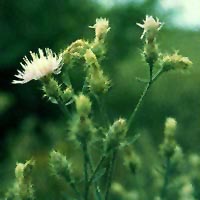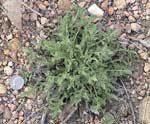Diffuse Knapweed
Centaurea diffusa Lam.; Acosta diffusa (Lam.) Sojak
Keys to Identification
- When leaves are young, they are covered by fine hairs.
- Flowers are mostly white or purple, and are located on each branch tip.
- The bracts surrounding each flower bear 4 to 5 pairs of lateral spines and one, long terminal spine. Diffuse knapweed can resemble spotted knapweed with the black tipped bracts. The difference is the sharp spine at the end of the bract that is characteristic of diffuse knapweed.
Family
Sunflower (Asteraceae )
Other Names
Spreading knapweed, tumble knapweed
USDA Code
CEDI3
Legal Status
Colorado Noxious Weed List B
Identification
Lifecycle
Biennial or short-lived perennial
Growth form
Forb
Flower
Flowerheads are broadly urn-shaped, 0.6-0.8 in tall, solitary or in clusters of 2-3 at the ends of the branches. Floral bracts are yellowish with a brownish margin, sometimes spotted, fringed on the sides, and terminating in a slender bristle or spine. The heads contain two types of flowers, ray flowers around the edges surrounding tubular disk flowers. The ray flowers are white, rose-purple, to lavender. June-Aug.
Seeds/Fruit
Seeds are light brown to black.
Leaves
Basal leaves are stalked and divided into narrow, hairy segments. Stem leaves are smaller, alternate, less divided, stalkless, and become bract-like near the flower clusters.
Stems
Stems are upright, 4-24 in tall, highly branched, angled, with short, stiff hairs on the angles.
Roots
Taproot.
Seedling
Seedlings have finely divided leaves that are covered with short hair.
Similar Species
Exotics
Diffuse knapweed may be distinguished from other knapweeds by the terminal spine on the floral bract.
Natives
None.
Impacts
Agricultural
Diffuse knapweed reduces the productivity of rangeland by displacing desirable forage species.
Ecological
Diffuse knapweed is a pioneer species that can quickly invade disturbed and undisturbed grassland, shrubland, and riparian communities. Once established, diffuse knapweed outcompetes and reduces the quantity of desirable native species such as perennial grasses. Diffuse knapweed contains allelopathic chemicals, which can suppress competitive plant growth and create single species stands (Watson and Renney 1974). The densities of these stands can range from 1-500 plants/m2. The replacement of native grassland with diffuse knapweed can reduce biological activity and increase soil erosion (Sheley et al. 1997).
Human
Some people develop a rash when handling the plants.
Habitat and Distribution
General requirements
Diffuse knapweed is found on plains, rangelands, and forested benchlands. It is generally found on light, dry, porous soils. Diffuse knapweed has been observed in elevations up to 7,000 feet (Zimmerman 1997). It prefers open habitats to shaded areas (Watson and Renney 1974). Diffuse knapweed is not common on cultivated lands or irrigated pasture because it cannot tolerate cultivation or excessive moisture (Watson and Renney 1974).
Distribution
Diffuse knapweed is now common in the Front Range counties, and has been reported in scattered infestations from both the east and west slope of Colorado.
Historical
Native to Eurasia.
Biology/Ecology
Lifecycle
Diffuse knapweed plants first form low rosettes and may remain in this form for one to several years depending on environmental conditions. Diffuse knapweed plants that complete their juvenile growth by the fall overwinter as rosettes and bolt in early spring (Watson and Renney 1974). Diffuse knapweed plants that have not finished the juvenile stage by the end of fall remain as rosettes through the second year and bolt during the third year. Flower buds are formed in early June and flowering occurs in July and August (Watson and Renney 1974). Mature seeds are formed by mid-August (Watson and Renney 1974).
Mode of reproduction
Reproduces by seeds.
Seed production
A single diffuse knapweed plant can produce up to 18,000 seeds (Harris and Cranston 1979) and a stand of diffuse knapweed can produce up to 40,000 seeds per square meter (Watson and Renney 1974).
Seed bank
Seeds may remain dormant for several years.
Dispersal
Seed dispersal for diffuse knapweed is mainly by wind (Watson and Renney 1974). When the seed capsule sways in the breeze or is disturbed, the seeds fall from the small opening in top of the flower head and are distributed around the parent plant (Watson and Renney 1974). However, most of the involucres remain closed until the plant dries up, breaks off at ground level and effectively becomes a tumbleweed, allowing seeds to be individually dispersed over long distances (Zimmerman 1997). Diffuse knapweed stalks readily lodge under vehicles, expanding their long distance dispersal.
References
Beck, G. K. 1997. Natural resources series, diffuse knapweed. Colorado State University Cooperative Extension. Internet 05/05/98. Available: http://ozma.jefferson.co.us/dpt/openspac/weed/dfknapwd.htm
Fletcher, R.A., and A.J. Renney. 1963. A growth inhibitor found in Centaurea spp. Canadian Journal of Plant Science 43:475-481.
Harris, P., and R. Cranston. 1979. An economic evaluation of control methods for diffuse and spotted knapweed in western Canada. Canadian Journal of Plant Science 59:375-382.
Niefoff, J. E-mail message-broadcast. Sent 9-12-97, 9:29 AM.
Roché, B.E. and C.T. Roché. 1999. Diffuse knapweed. In: R.L. Sheley and J.K. Petroff (eds.) Biology and management of noxious rangeland weeds. Oregon State University Press, Corvallis, pg. 217-230.
Schirman, R. 1981. Seed production and spring seedling establishment of diffuse and spotted knapweed. Journal of Range Management 34:45-47.
Sheley, R.L., B.E. Olson, and L.L. Larson. 1997. Effect of weed seed rate and grass defoliation level on diffuse knapweed. Journal of Range Management 50: 39-43.
Watson, A.K., and A.J. Renney. 1974. The biology of Canadian weeds Centaurea diffusa and C. maculosa. Canadian Journal of Plant Science 54:687-701.
Youtie, B. 1997. Weed control as the first step in protecting and restoring native plant communities on northeast Oregon natural areas. Conservation and Management of Native Plants and Fungi. Native Plant Society of Oregon, Corvallis, Oregon. pages 78-82.
Youtie, B. and J. Soll. 1994. Non-chemical control of diffuse knapweed (Centaurea diffusa). Knapweed Newsletter 8(3):2-3. Washington State University Cooperative Extension, Pullman WA.
Zimmerman, J.A.C. 1997. Ecology and distribution of Centaurea diffusa Lam., Asteraceae. USGS Biological Resources Division , Colorado Plateau Field Station-Flagstaff, Arizona. Internet 02/16/98. Available: http://www.nbs.nau.edu/FNF/Vegetation/Exotics/diffusa/ diffusa.html



